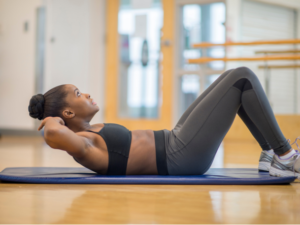8 Fitness Myths Debunked
Fitness advice is everywhere, but with that comes a heap of myths that can really sideline your progress. You wouldn’t believe how many people are still caught up in outdated or just plain wrong ideas about getting in shape. By sorting out the facts from the fiction, you can sidestep these pitfalls and move forward smartly and safely on your fitness journey.


The flood of information out there makes it crucial to rely on evidence-based approaches to fitness. When you land on advice that sounds too simple or promises ridiculous results, it’s time to switch into skeptic mode. Doing the detective work on any fitness claim is key because knowing why a certain workout’s beneficial or why a myth doesn’t hold water can power up your fitness smarter than ever.
So, let’s get real. Here, we are laying down eight big, booming fitness myths that need debunking once and for all. Get ready to overhaul any misunderstandings you might have, clear out the clutter, and replace it with knowledge that’s grounded, actionable, and downright sensible.
Myth 1: Spot Reduction Works
Spot reduction is this persistent myth that still trips up a lot of fitness newbies and veterans alike. It promises that doing specific exercises will zap fat away from targeted areas like the belly or thighs. Wouldn’t that be the dream? Sadly, though, our bodies don’t play by those rules.
Believe it or not, the science of fat loss is pretty straightforward. When you work out, the body pulls energy from all over—not just from the area you’re working. Genetics and overall body composition play the largest roles in where you shed fat first. For example, hitting hundreds of sit-ups won’t give you visible abs if there’s a layer of fat still covering them.
For those wanting to lose fat smartly, focus on a combination of a balanced diet, cardio, and strength training to rev up your metabolism and tone up all over. It’s all about thinking big picture here. Instead of narrowly targeting single-body parts, aim for whole-body conditioning. That’s the realistic and effective avenue to losing weight wherever your body decides.
Myth 2: Cardio is the Only Way to Lose Weight
Time to put this one to bed: cardio is not the one-stop-shop for weight loss. Sure, it’s part of the equation, but definitely not the sole player. Relying solely on cardio can actually lead to a fitness plateau after a while. Your body adapts to routines pretty quickly, and mixing things up is the key to breaking through these ruts.

Enter strength training—a powerhouse for anyone serious about shedding pounds. Pumping iron doesn’t just build muscle; it ramps up your metabolism in the long haul. More muscle means your body burns more calories even when you’re just chilling on the couch. How cool is that?
Now, think about creating a workout plan that balances both. Try pairing cardio sessions with weight sessions. Whether it’s Zumba one day and weightlifting the next or a circuit routine that incorporates both, diversity is what keeps your body guessing and progressing.
What really gets results is consistency and a balanced mix of exercise types. With the right mix, you’re building a strong foundation that supports your goals, whether that involves dropping pounds, getting stronger, or staying in shape.
Myth 3: Women Will Get Bulky Lifting Weights
Here’s a fear many women have when stepping into the weight room: lifting weights will turn them into a bodybuilder. Let’s clear up some things. Lifting weights won’t automatically bulk you up, and, in fact, it’s a fantastic way to shape and tone your body the way you want.
The idea that weights cause bulkiness actually overlooks some basic biology. Women generally produce lower levels of testosterone compared to men, a key hormone for muscle growth. So, bulking up takes a deliberate approach with heavy lifting and, often, a surplus in calorie intake. For most women, resistance training serves to enhance strength and muscle definition instead.
What does lifting mean for the average gym-goer? Women can lift weights and enjoy benefits such as increased metabolism, stronger bones, and improved mood—all without the worry of bulking up unexpectedly. Adopting various strength workouts, whether it’s bodyweight exercises, kettlebells, or traditional weight lifting, brings about muscular endurance and an athletic physique.
The takeaway here is to ditch the concern about getting bulky. Embrace weight training as a smart tool for staying fit and enhancing health. Your newfound strength won’t just show up in the mirror; it’ll resonate through your everyday life as you feel stronger and more confident.
Myth 4: More Exercise is Always Better
More isn’t always better when it comes to exercising. It’s a common misconception that pushing your body to its limits every single day will fast-track results. In reality, overtraining can actually set you back, causing burnout, injuries, and even making you sick.
Our bodies need time to recover and rebuild after workouts. Muscles repair and grow stronger during rest, not while you’re hammering away at the gym. Without proper recovery, you risk wearing yourself out and stalling any progress you’re looking to make.
To make the most out of your fitness routine, ensure you balance exercise intensity with rest periods. Incorporate rest days into your weekly plan, and listen to what your body tells you—whether that’s taking a light yoga class or catching up on some sleep.
A solid plan might include moderate workouts most days with a couple of high-intensity sessions and, crucially, rest days. Pay attention to how you feel; if you’re constantly fatigued, it might be time to rethink your rest strategy. Your body—and your results—will thank you.
Myth 5: You Must Feel Sore to Know You’ve Worked Hard
Feeling sore after a workout is often seen as a badge of honour, but it’s not the only indicator of a good workout. Muscle soreness, known as delayed onset muscle soreness (DOMS), can happen when you introduce new exercises or up the intensity of your workouts, but it doesn’t mean you’ve accomplished more.
Soreness results from tiny tears in muscle fibres, which are part of the normal repair process. However, constantly chasing that post-workout ache is a recipe for overuse injuries and burnout. What you should focus on is how your strength, endurance, and flexibility are improving over time. These are signs that your workouts are effective, even if they don’t leave you hobbling around the next day.
Instead of equating soreness with success, consider mixing up your routine while maintaining good form and progressing gradually. This approach helps in building up strength without unnecessary strain on your muscles.
Key signs of a successful workout include improved performance, such as being able to lift heavier weights or run faster. Pay attention to your energy levels and motivation as well—if these are up, you’re likely on the right path, regardless of muscle soreness.
Myth 6: The More You Sweat, The More You Burn
Sweating is often seen as a direct measure of workout intensity and calorie burn. But in reality, sweating is simply your body’s way of cooling down. Everyone sweats differently based on factors like genetics, fitness level, and even the temperature of the room.

Some people hit the sweat jackpot with just a slight jog, while others may need to really push it to feel the first drip. But more sweat doesn’t equate to more calories burned. It’s possible to have an efficient calorie-burning session with minimal sweating, especially if your workout isn’t overly intense or is performed in a cooler environment.
So, how do you gauge workout effectiveness? Look for improvements in your performance metrics, like speed or endurance, and track how your body feels during and after workouts. Are you stronger or faster compared to weeks ago? If yes, then you’re on the right track.
Rely on these other signals than just sweat to measure progress, like heart rate for intensity and how much you’re improving over time. Remember, it’s about quality of movement rather than the quantity of sweat.
Myth 7: Crunches are the Key to a Flat Stomach
Crunches are the classic go-to when people aim for a flat stomach, but relying solely on them isn’t the ticket to washboard abs. This myth ties back to the whole spot reduction idea that working out a specific area will get rid of fat there, which we know doesn’t really work.

While crunches can strengthen your core, they won’t magically melt away belly fat. Achieving a flat stomach is more about a balanced approach that includes varied exercises and a clean diet. Think planks, leg raises, and rotations for engaging the entire core area effectively.
Pairing a strong exercise routine with consistent, healthy eating habits is the secret sauce. This means focusing on a nutrient-dense diet that supports fat loss across your whole body, not just around your midsection.
Remember, abs are “made in the kitchen” as much as they are in the gym. So, prioritise a balanced diet combined with full-body workouts for the most effective approach toward achieving that enviable flat stomach.
Myth 8: No Pain, No Gain
The phrase ‘no pain, no gain’ is more than just catchy; it’s misleading. Many people believe pushing through pain is necessary for progress, but pain isn’t always a positive signal. Achieving fitness goals should be about challenging yourself safely, not risking injury.
Pain during exercise can be a sign of something going wrong. It’s crucial to differentiate between discomfort that comes from challenging workouts, which can be normal, and sharp or unusual pain that might indicate injury. Understanding your body’s responses is key to avoiding setbacks and staying on track.
Sustainable progress comes from consistency and mindful workouts. Incorporate different types of exercises—like strength training, cardio, and flexibility workouts—and always listen to your body. Rest when needed and don’t shy away from recovery days as they’re part of the process.
Chasing pain isn’t necessary for achievement. Effective workouts are those you can repeat week after week without dread or risk. Focus on enjoying the journey and celebrate the small wins too. That’s how you measure true gain.
Conclusion: Moving Forward with Fitness Knowledge
Now that you’ve got the lowdown on some major fitness myths, it’s time to power forward with clear, accurate info in your corner. These myths could really trip you up, but knowing the facts can set you on a smarter path. You’re equipped to make informed choices that match your goals and suit your body’s needs.
Staying savvy in your fitness journey means recognising that what works for one person might not work for another. Always personalise your approach. While trends and fads come and go, sticking to evidence-based practices ensures lasting progress and health.
Keep exploring, keep learning, and stay curious about what your body can achieve. Whether it’s getting stronger, faster, or just feeling more energised, use what you’ve learned to push towards those goals in a way that’s practical and enjoyable.
And hey, don’t hesitate to reach out to professionals when in doubt. Whether it’s a fitness coach, a dietitian, or a physical therapist, tapping into expert advice is invaluable – and we cover all of these! Consider every step as a way to get better, healthier, and more confident. Here’s to your fitness success!
Click here to sign up for future updates…
Disclaimer: This page contains affiliate links. If you choose to make a purchase after clicking a link, we may receive a commission at no additional cost to you. Thank you for your support!






Hello Nikki!
This article does a fantastic job of tackling common fitness myths that can often discourage or mislead people on their health journeys! I appreciate how each myth is explained and debunked with practical and evidence-based insights—it makes fitness feel much more approachable.
One myth that really resonated with me is the idea that “you have to exercise for hours to see results.” It’s such a relief to know that even shorter, consistent workouts can make a big difference. I’m curious, though—how would you recommend structuring a 20–30 minute workout to maximize its effectiveness? Are there specific types of exercises that deliver the best results in less time?
Also, the myth about “spot reduction” is such a common misconception. Do you think more education around nutrition alongside fitness could help people better understand how fat loss works overall?
Thank you for sharing this empowering and informative article—it’s a great motivator for anyone looking to embrace fitness with a smarter, more balanced approach!
Angela M 🙂
Hi Angela,
Thank you for your kind review! I am thrilled to hear that the article resonated with you and helped clarify some common fitness myths.
For structuring a 20–30 minute workout, I recommend focusing on high-intensity interval training (HIIT). This involves alternating between short bursts of intense exercise and brief rest periods. You can incorporate exercises like hill climbers, squats, sit ups, or push-ups. Aim for a circuit of 4-5 exercises, performing each for 40 seconds, followed by a 20-second rest, and repeat the circuit 3-4 times. This approach maximises calorie burn and builds strength efficiently in a shorter time.
Regarding the myth of spot reduction, I definitely agree that more education on nutrition is crucial. Understanding that fat loss is a systemic process—where the body decides where to lose fat based on genetics and overall activity—can help people set more realistic expectations. Combining good nutrition with a balanced fitness routine will lead to more sustainable results. Understanding the science can help you understand your body.
Thank you again for your engaging questions!
KR
Nikki
I absolutely loved your article on fitness myths! It’s refreshing to see such clarity on topics that often confuse so many of us. I’ve personally struggled with some of these misconceptions, especially the idea that lifting weights would bulk me up. Once I started incorporating strength training into my routine, I found not only did I feel stronger, but my body became more toned and defined without the bulk I feared.
I also appreciate how you highlighted the myth about exercise compensating for a bad diet. This resonates with me because I used to think that a good workout could justify indulging in unhealthy foods. It took some time, but I learned that nutrition plays a crucial role in overall health and fitness. Have you had similar experiences with fitness myths in your journey?
Thank you so much for your thoughtful review! We are delighted to hear that the article resonated with you and helped debunk some common fitness myths you’ve encountered.
We can relate to your experience with the fear of bulking from weightlifting. It’s a misconception many people have, and I’m glad you found that strength training not only made you feel stronger but also resulted in a more toned physique. It’s a testament to how beneficial weightlifting can be, especially for overall fitness and body composition.
As for the myth about exercise compensating for a poor diet, we have definitely encountered that as well via our clients and personally. We used used to think hitting the gym regularly was enough to override any dietary indulgences. Over time, we have learned that balanced nutrition is essential for optimising performance and achieving fitness goals. It’s all about creating a holistic approach that includes both exercise and healthy eating habits.
Thank you for sharing your journey!
KR
Niro Active Team